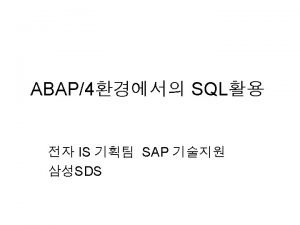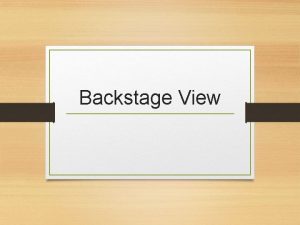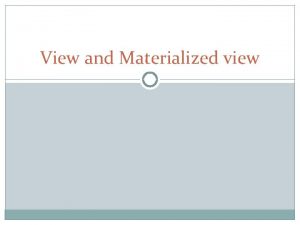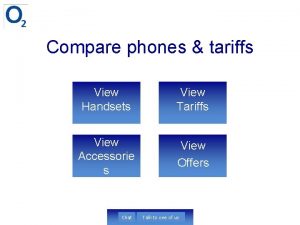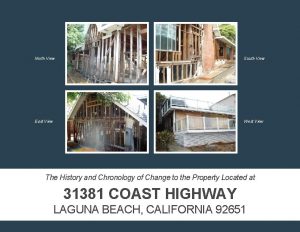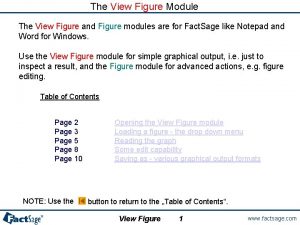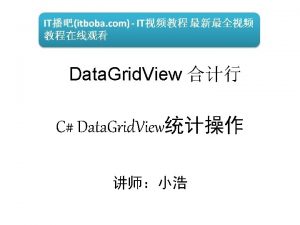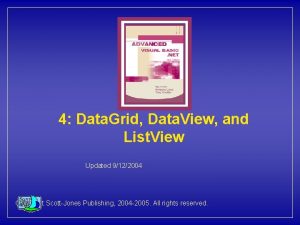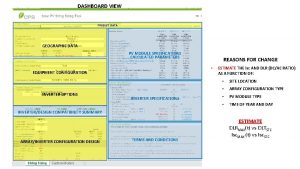The View Data module Use View Data to




































- Slides: 36

The View Data module Use View Data to examine stored compound data (H, S, Cp(T), G, etc. ) in Compound type databases and list solutions and their constituents in Solution type databases. Table of contents Section 1 2 3 4 Table of contents Activate the View Data module View Data of a Compound Database General information on a compound Phases and References Section 5 Section 6 Section 7 Heat capacity expressions – Cp(T) Data for H, S, and G functions Additional Data entries Magnetic data and Cp expressions for Fe Real gas coefficients for carbon dioxide CO 2 Volume data - expansivities, compressivities and derivative of bulk modulus, Data for Si. O 2 (continued) View Data 1. 1 www. factsage. com

The View Data module Table of contents (continued) Section 8 Executing calculations: The Menu Bar Thermodynamic Data for Cu: Tabular Output Tabular output for Fe Plotted Cp data for Fe Section 9 Section 10 Section 11 Adding a compound database to the list Data in 2 or more compound databases View Data of a Solution Database The solution phase list window Adding a solution database to the list Data in 2 or more solution databases. View Data 1. 2 www. factsage. com

The View Data module 1° Click on View Data in the main Fact. Sage window. View Data 2 www. factsage. com

View Data of a Compound Database The following two slides show a search for a list of compounds in a given system is prepared and executed. The resulting list of species is shown and the various options in the Menu bar are indicated. Note that the search can also be for a single compound with a given formula. The appropriate entry formats are shown in the first of the two slides. View Data 3. 0 www. factsage. com

View Data of a Compound Database Pressure and Energy units Possibility to add other databases in the data search see slide 18 For example, the elements Cu and O Click on «OK» to scan the Main FACT pure substance database for all species of Cu and O View Data 3. 1 www. factsage. com

The Menu Bar Units Menu: Energy Summary Menu: Pressure • All species containing Cu and O • All species containing Cu • All species containing O Edit Menu: Help is provided through a slide show presentation File Menu: Double-click or «Enter» to view the compound data of Cu View Data 3. 2 www. factsage. com

Phases and References of a compound The following two slides show the display window with the basic information on a particular compound. The substance name and the molecular weight are shown. The Phases Tab in the display window is related to the phases and the temperature ranges for which data are available. The second slide shows the result when clicking on the Refs. Tab. View Data 4. 0 www. factsage. com

Phases Retrieval of data on Cu from the Main FACT pure substances database. Species name, formula weight and density References Cu has 33 phases – S, L and G. There are 2 temperature ranges for Cu (liq) – each has its own CP expression. View Data 4. 1 www. factsage. com

References Bibliographic data The full name of the database appears in the Status Bar: [C: Fact. WinFACTDATAFACTBASE. CDB]. View Data 4. 2 www. factsage. com

The basic compound data: H 298, S 298 and Cp coefficients The following slide shows the basic data that are stored for any compound in a database. These are: – the enthalpy of formation DH 298, – the entropy S 298 and – the coefficients of the Cp-polynomial In many cases it is necessary to use more than one set of coefficients of Cp in order to describe the Cp-curve with sufficient accuracy. Furthermore, if a compound undergoes phase changes with increase of temperature, each new phase will have at least one new Cp-polynomial. View Data 5. 0 www. factsage. com

Heat capacity expressions – Cp(T) The heat capacity expression of solid copper between 298 K and 1100 K is: Cp(T) = [33. 5575315 - 9. 13164780 × 10 -3 T + 212626. 807 T-2 + 6. 86736674 × 10 -6 T 2 - 2799. 24538 T-1] (J/mol·K) Note that the 2 nd Cp expression for the liquid is constant at temperatures over 900 K. View Data 5. 1 www. factsage. com

Different derived thermodynamic functions: H(T), S(T) and G(T) The basic data DH 298, S 298 and Cp(T) can be used to derive the temperature dependence of the enthalpy, H(T), the entropy, S(T) and, most important, the Gibbs energy, G(T). Combined in the Gibbs-Helmholtz equation: View Data 6. 0 www. factsage. com

Enthalpy expressions – H(T) = [ 7002. 148876 + 33. 55753148 T - 4. 565823899 × 10 -3 T 2 212626. 8066 T-1 + 2. 289122247 × 10 -6 T 3 - 2799. 245381 ln. T] (J/mol) View Data 6. 1 www. factsage. com

Entropy expressions – S(T) = [ -163. 8086625 + 33. 55753148 ln. T - 9. 131647798 × 10 -3 T 106313. 4033 T-2 + 3. 433683370 × 10 -6 T 2 + 2799. 245381 T-1] (J/mol·K) at 1 bar View Data 6. 2 www. factsage. com

Gibbs Energy expressions – G(T) = [ 4202. 903495 + 197. 3661939 T - 4. 565823899 × 10 -3 T 2 106313. 4033 T-1 + 1. 144561123 × 10 -6 T 3 - 2799. 245381 ln. T 33. 55753148 T ln. T] (J/mol) at 1 bar View Data 6. 3 www. factsage. com

Additional basic data of a compound The compound database format permits not only the storage of the standard data shown in the previous slides. It is also possible to enter data for the magnetic Gibbs energy of a solid compound, basic data the permit the calculation of virial coefficients of gaseous compounds, and data to treat the pressure dependence of the Gibbs energy of condensed compounds according to the Birch-Murnaghan approach. View Data 7. 0 www. factsage. com

Magnetic data and Cp expressions for Fe and p is the P Factor and b is the Structure Factor Fe View Data 7. 1 www. factsage. com

Real gas coefficients for carbon dioxide CO 2 The truncated virial equation of state is employed to treat real gases: B is estimated (for pure gases and mixtures) by the Tsonopoulos method* from Pc, Tc and omega (the acentric factor) for the pure gases. Gases are treated as non-polar. For ideal gases, the value of B is zero. * «An Empirical Correlation of Second Virial Coefficients» by C. Tsonopoulos, AICh. E Journal, vol. 20, No 2, pp. 263 -271, 1974. For example, CO 2 View Data 7. 2 www. factsage. com

Data for Si. O 2 For example, Si. O 2 View Data 7. 3 www. factsage. com

Volume data - expansivities, compressivities and derivative of bulk modulus Derivative of the bulk modulus expression: Compressibility expression (compressibilities): Thermal expansion expression (expansivities): View Data 7. 4 www. factsage. com

Using the Menu bar to generate thermodynamic property values The following slides show the View Data module can also be used to calculate thermodynamic properties of a compound. The properties values can be displayed in tables and also in graphs. The Menu bar contains the appropriate option buttons. View Data 8. 0 www. factsage. com

The Menu Bar Graph Menu: Table Menu: Selection of the temperature range and step. Selection of the phase(s). Databases Menu: View Data * Selection * of thermodynamic data: Cp, H, G or S …vs T 8. 1 www. factsage. com

Thermodynamic Data for Cu: Tabular Output Menu: Clos e Save Prin t standard state all phases (S, L, G) + thermodyna mic data at T = 298. 15 K From 500 K to 2500 K in steps of 500 K View Data 8. 2 www. factsage. com

Tabular output for Fe …with an associated enthalpy of transformation of (34587. 3 - 33574. 4) = 1012. 9 J At this temperature G(S 1) = G(S 2) (two phases in equilibrium). The allotropic transformation S 1 ® S 2 (alpha ® gamma) at 1184. 81 K The allotropic transition reverses at 1667. 47 K where S 2 ® S 1 (gamma ® delta). The enthalpy of fusion is 13806. 9 J at 1810. 95 K. Phase transitions S 1®S 2®S 1®L® G as T increases. View Data 8. 3 The enthalpy of vaporization to form monatomic Fe(g) at 1 atm is (482861. 0 133229. 8) = 349631. 2 J at 3131. 93 K. www. factsage. com

Plotted Cp data for Fe Curie temperature = 1043 K View Data 8. 4 www. factsage. com

The View Data module links Databases with the Fact. Sage program, I The following slides show the View Data module is used in order to link additional Compound databases with the Fact. Sage program. Once several databases are linked with Fact. Sage it is possible to use them in combined searches for compounds. The result of such a combined search is shown. NOTE: The additionally linked databases are also available for use in other modules. Thus View Data can be considered a general entry point for databases. View Data 9. 0 www. factsage. com

Adding a compound database to the list 1. Press the « Add… » button in the Compound Databases (1) frame. 2. Select «compound» 3. This opens the dialog box “Compound - list of databases”. Type in the full name or browse to locate. View Data 9. 1 www. factsage. com

Adding a compound database to the list (continued) 4. Enter a nickname (4 characters). Enter a description (one line). Click on «OK» . 5. The SGTE database is now included in the list of compound databases. View Data 9. 2 www. factsage. com

Data in 2 or more compound databases « All Databases » 15 compounds from the FACTBASE database and 2 FACT from the SGTEBASE database for a total of 17 SGTE compounds. View Data 9. 3 www. factsage. com

Using View Data with Solution databases In addition to the use of View Data for the inspection of Compound databases it is also possible to apply this module for the search in Solution databases. The following slides will give an overview of this application. View Data 10. 0 www. factsage. com

View Data of a Solution Database Pressure and Energy units Solution Database Possibility to add other databases in the data search – see slide 23. For example, the elements Cu, Cu Fe and S Click on «OK» to scan the Main FACT real solutions database for all solutions containing Cu, Cu Fe and S. View Data 10. 1 www. factsage. com

The solution datasets window Units Menu: Energy Pressure Edit Menu: File Menu: Summary Menu: • All solutions containing Cu, Cu Fe or O • All solutions containing Cu • All solutions containing Fe • All solutions containing O Help is provided through a slide show presentation The full name of the Main FACT real solutions database appears in the Status Bar: [C: Fact. WinFACTDATAFACTSOLN. S DB]. www. factsage. com View Data 10. 2

The View Data module links Databases with the Fact. Sage program, II The following slides show the View Data module is used in order to link additional Solution databases with the Fact. Sage program. Once several databases are linked with Fact. Sage it is possible to use them in combined searches for compounds. The result of such a combined search is shown. NOTE: The additionally linked databases are also available for use in other modules. Thus View Data can be considered a general entry point for databases. View Data 11. 0 www. factsage. com

Adding a solution database to the list 1. Press « Add… » button in the Solution Databases (1) frame. 2. Select «solution» 3. This opens the dialog box “Solution - list of databases”. Type in the full name or browse to locate. View Data 11. 1 www. factsage. com

Adding a solution database to the list (continued) 4. Enter a nickname (4 characters). Enter a description (one line). Click on «OK» . View Data 5. The SGTE database is now included in the database list. 11. 2 www. factsage. com

Data in 2 or more solution databases « All Databases » A total of 10 Solutions: 4 solutions from the FACT database and 6 from the SGTE database. View Data 11. 3 www. factsage. com
 C device module module 1
C device module module 1 How might a business use a blog module 11
How might a business use a blog module 11 Hát kết hợp bộ gõ cơ thể
Hát kết hợp bộ gõ cơ thể Bổ thể
Bổ thể Tỉ lệ cơ thể trẻ em
Tỉ lệ cơ thể trẻ em Gấu đi như thế nào
Gấu đi như thế nào Chụp tư thế worms-breton
Chụp tư thế worms-breton Alleluia hat len nguoi oi
Alleluia hat len nguoi oi Các môn thể thao bắt đầu bằng tiếng bóng
Các môn thể thao bắt đầu bằng tiếng bóng Thế nào là hệ số cao nhất
Thế nào là hệ số cao nhất Các châu lục và đại dương trên thế giới
Các châu lục và đại dương trên thế giới Công thức tiính động năng
Công thức tiính động năng Trời xanh đây là của chúng ta thể thơ
Trời xanh đây là của chúng ta thể thơ Cách giải mật thư tọa độ
Cách giải mật thư tọa độ Phép trừ bù
Phép trừ bù độ dài liên kết
độ dài liên kết Các châu lục và đại dương trên thế giới
Các châu lục và đại dương trên thế giới Thơ thất ngôn tứ tuyệt đường luật
Thơ thất ngôn tứ tuyệt đường luật Quá trình desamine hóa có thể tạo ra
Quá trình desamine hóa có thể tạo ra Một số thể thơ truyền thống
Một số thể thơ truyền thống Cái miệng nó xinh thế chỉ nói điều hay thôi
Cái miệng nó xinh thế chỉ nói điều hay thôi Vẽ hình chiếu vuông góc của vật thể sau
Vẽ hình chiếu vuông góc của vật thể sau Biện pháp chống mỏi cơ
Biện pháp chống mỏi cơ đặc điểm cơ thể của người tối cổ
đặc điểm cơ thể của người tối cổ Thứ tự các dấu thăng giáng ở hóa biểu
Thứ tự các dấu thăng giáng ở hóa biểu Vẽ hình chiếu đứng bằng cạnh của vật thể
Vẽ hình chiếu đứng bằng cạnh của vật thể Fecboak
Fecboak Thẻ vin
Thẻ vin đại từ thay thế
đại từ thay thế điện thế nghỉ
điện thế nghỉ Tư thế ngồi viết
Tư thế ngồi viết Diễn thế sinh thái là
Diễn thế sinh thái là Các loại đột biến cấu trúc nhiễm sắc thể
Các loại đột biến cấu trúc nhiễm sắc thể Số nguyên là gì
Số nguyên là gì Tư thế ngồi viết
Tư thế ngồi viết Lời thề hippocrates
Lời thề hippocrates







































